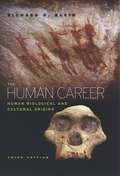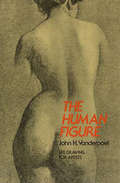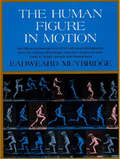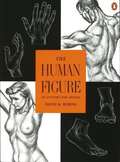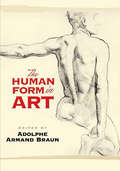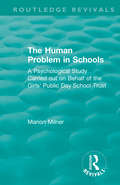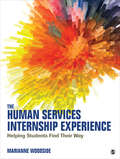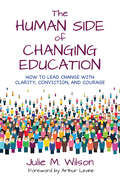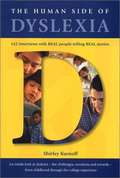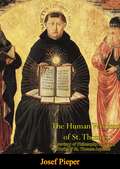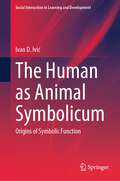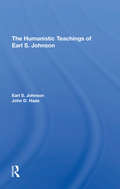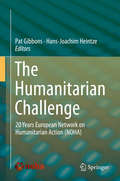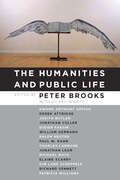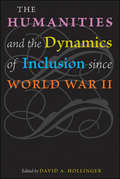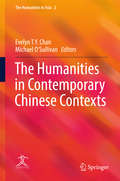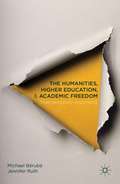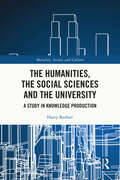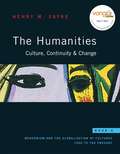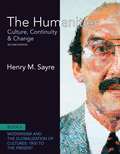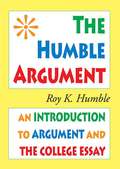- Table View
- List View
The Human Career: Human Biological and Cultural Origins (3rd edition)
by Richard G. KleinKlein (anthro, U. of Chicago) summarizes our current knowledge and ongoing debates about human evolution from the earliest primates to modern man. Both the fossil and archaeological evidence is examined, showing the relationship between human form and behavior.
The Human Development Experience (Second Edition): A Psycho-Social Approach to Human Lifespan Development
by Philip B. Terry-SmithThe human development experience is both a fascinating and somewhat troubling study. We are faced with some of the greatest challenges and celebrate some of the greatest accomplishments as we journey through our life time. This text offers a unique and targeted interpretation of human lifespan development based on a psycho-social approach to development.
The Human Figure
by John H. VanderpoelThis great classic is still unrivalled for its clear, detailed presentation of thousands of fundamental features of the human figure. Every element of the body (such as the overhang of the upper lip; the puckering at the corners of the mouth; the characteristic proportions of the head, trunk, limbs, etc.; the tension between connected portions of the body; etc.) is carefully and concisely pointed out in the text. Even more helpful are the 430 pencil and charcoal drawings that illustrate each feature so that you are, in effect, shown what to look for by a master teacher. The result is the only art instruction book which not only illustrates details of the body but directs your attention at every stage to a host of subtle points of shading, curvature, proportion, foreshortening, muscular tension, variations due to extreme age or youth, and both major and minor differences in the structure and representation of the male and female figure. Comprehensive discussions and drawings cover the eyes; nose, mouth and chin; ear; head, trunk, back and hips; neck, throat, and shoulder; shoulder and arm; hand and wrist; leg; foot; the complete figure; and other interdependent groups of structures. This is the human figure as the artist, art student, and art teacher must know it in order to avoid many deceptive errors unfortunately common in much modern portraiture, painting, and illustrative art.
The Human Figure in Motion
by Eadweard MuybridgeThis is the largest selection ever made from the famous Muybridge sequence high-speed photographs of human motion. Containing 4,789 photographs, it illustrates some 163 different types of action: elderly man lifting log, woman sweeping, woman climbing ladder, men boxing and wrestling, child crawling, man lifting weight, man jumping, and 155 other types of action, some of which are illustrated by as many as 62 different photographs. Taken at speeds ranging up to 1/6000th of a second, these photographs show bone and muscle positions against ruled backgrounds. Almost all subjects are undraped, and all actions are shown from three angles: front, rear, and three-quarter view. These historic photographs, one of the great monuments of nineteenth-century photography, are reproduced original size, with all the clarity and detail of the originals. As a complete thesaurus of human action, it has never been superseded. Muybridge was a genius of photography, who had unlimited financial, technical, and scientific backing at the University of Pennsylvania. This volume presents the final selection from more than 100,000 negatives made at an expenditure of more than $50,000. It has never been superseded as a sourcebook for artists, students, animators, and art directors. "An unparalleled dictionary of action for all artists, photographers." -- American Artist."Impressive and valuable collection." -- Scientific American.
The Human Figure: An Anatomy For Artists
by David K. RubinsA brief yet in-depth presentation of the human anatomy.
The Human Form in Art
by Adolphe Armand BraunAs individual as a snowflake, the human body is a marvel of form and function. This dramatic compilation of 166 studies—photographs, line drawings, and sculptures—serves as both an exhilarating exhibition and an important reference. Key topics include:AnatomyProportionMotionOther advice covers the selection of models, the human form in sculpture, and the role of art in the theater. Artists at every level of experience as well as art lovers will benefit from this classic guide.
The Human Problem in Schools: A Psychological Study Carried out on Behalf of the Girls' Public Day School Trust (Routledge Revivals)
by Marion MilnerPublished in 1938, this book documents a psychological study carried out on behalf of the Girls’ Public Day School Trust. Comprising 25 schools, the trust set the standard for girls’ education for the first decade of the twentieth century and the pioneering study was set to serve the cause of national education. Marion Milner documents the study and her findings across four sections with topics covered including: intelligence testing, classroom observations, interpretation of material, varying effects of the environment and interviewing techniques. Sections also discuss practical implications from the research, and the importance of the psychologist in the classroom. This book provides a detailed study of mental development and education in adolescent girls in the 1930’s as well as considering how important it can be to have a psychologist in the classroom. An original study that will still be of interest to researchers and academics in the fields of education, psychology and gender studies today.
The Human Services Internship Experience: Helping Students Find Their Way
by Marianne R. Woodside"This text is the ‘bread and butter’ for interns who seek to work in human service fields." -Fred Hall, Mississippi College The Human Services Internship Experience: Helping Students Find Their Way aims to help students in field-based courses bridge theory and practice during their internships. The goal is to show students how to apply their academic work in a real-world setting and to confirm and expand their identity as human service professionals. To meet this goal, Marianne Woodside assists students in developing that identity, learn to work within an agency setting, learn to use supervision effectively, and to be aware of multicultural and ethical perspectives in human service delivery and supervision as well as develop the appropriate knowledge, skills, and values to effectively perform the multiple roles of the human service professional. Students will learn how to successfully conclude the internship and transition from intern to employee.
The Human Services Internship Experience: Helping Students Find Their Way
by Marianne R. Woodside"This text is the ‘bread and butter’ for interns who seek to work in human service fields." -Fred Hall, Mississippi College The Human Services Internship Experience: Helping Students Find Their Way aims to help students in field-based courses bridge theory and practice during their internships. The goal is to show students how to apply their academic work in a real-world setting and to confirm and expand their identity as human service professionals. To meet this goal, Marianne Woodside assists students in developing that identity, learn to work within an agency setting, learn to use supervision effectively, and to be aware of multicultural and ethical perspectives in human service delivery and supervision as well as develop the appropriate knowledge, skills, and values to effectively perform the multiple roles of the human service professional. Students will learn how to successfully conclude the internship and transition from intern to employee.
The Human Side of Changing Education: How to Lead Change With Clarity, Conviction, and Courage
by Julie Margretta JungalwalaMake change humanly possible Today’s schools know they must make problem solving, collaboration, self-directed learning and creativity an integral part of the school’s DNA, but they don’t always know how. When we ask schools to change, we are asking human beings to change. This requires special tools and a human-centered approach. In The Human Side of Changing Education, leaders will learn to make sense of their challenging change journeys and accelerate effective implementation. With this practical framework that includes human-centered tools, resources and mini case studies, readers will learn to navigate and succeed on their unique path of change. Understand why resistance is to be expected and how to get through it. Discover three different kinds of change strategies and when to use which one Learn how to use the "messy middle" of change, where real transformation happens Change the heart of the system by enabling the hearts and minds of those who make schools work. "Julie Wilson is both a visionary and a pragmatist. Her book is a wonderfully clear and concise guide for leaders who seek to navigate the road to educational transformation." Tony Wagner, Author The Global Achievement Gap and Creating Innovators "If you want to understand what it takes to create innovative and lasting change, then forge ahead with The Human Side of Changing Education, and bravely create your own hero′s journey. This is a valuable guide, with practical advice and real-life examples to support you in this very complicated and challenging work." Ann Koufman-Frederick, Chief Academic Officer LearnLaunch Institute, MAPLE "If everyone working in U.S. K-12 education were to read this book and put even half of its thinking into practice, we would be well on our way to a far better society. It is timely, visionary, and relentlessly practical – a rare combination. Discover what our future could look like if enough of us dare to make it happen." Andy Calkins, Director Next Generation Learning Challenges at EDUCAUSE
The Human Side of Changing Education: How to Lead Change With Clarity, Conviction, and Courage
by Julie Margretta JungalwalaMake change humanly possible Today’s schools know they must make problem solving, collaboration, self-directed learning and creativity an integral part of the school’s DNA, but they don’t always know how. When we ask schools to change, we are asking human beings to change. This requires special tools and a human-centered approach. In The Human Side of Changing Education, leaders will learn to make sense of their challenging change journeys and accelerate effective implementation. With this practical framework that includes human-centered tools, resources and mini case studies, readers will learn to navigate and succeed on their unique path of change. Understand why resistance is to be expected and how to get through it. Discover three different kinds of change strategies and when to use which one Learn how to use the "messy middle" of change, where real transformation happens Change the heart of the system by enabling the hearts and minds of those who make schools work. "Julie Wilson is both a visionary and a pragmatist. Her book is a wonderfully clear and concise guide for leaders who seek to navigate the road to educational transformation." Tony Wagner, Author The Global Achievement Gap and Creating Innovators "If you want to understand what it takes to create innovative and lasting change, then forge ahead with The Human Side of Changing Education, and bravely create your own hero′s journey. This is a valuable guide, with practical advice and real-life examples to support you in this very complicated and challenging work." Ann Koufman-Frederick, Chief Academic Officer LearnLaunch Institute, MAPLE "If everyone working in U.S. K-12 education were to read this book and put even half of its thinking into practice, we would be well on our way to a far better society. It is timely, visionary, and relentlessly practical – a rare combination. Discover what our future could look like if enough of us dare to make it happen." Andy Calkins, Director Next Generation Learning Challenges at EDUCAUSE
The Human Side of Dyslexia: 142 Interviews with Real People Telling Real Stories
by Shirley KurnoffThe author writes: "My goal with this book is to make your journey as a parent a lot less painful and a lot more light-hearted; as a student to show you a way to cope; as a sibling to show you a caring way to understand your brother or sister. This book will give you encouragement and de-emphasize the negativity that comes with a learning difference. It will become your invisible support system, stories for you to emulate, stories to make you laugh or cry, stories that help you open up conversations with family members. On the surface this book taps into a highly visible audience of people associated directly with dyslexia. But these human stories also reach out to a broader audience--educators, the corporate world, even newlyweds with hereditary dyslexia. In essence, anyone who wants to know more about the social side of living with a learning difference and the social implications that come with dyslexia. The Human Side of Dyslexia is about life, about people."
The Human Wisdom of St. Thomas: A Breviary of Philosophy from the Works of St. Thomas Aquinas
by Josef PieperJosef Pieper has attached no commentary to the texts brought together in this breviary of the philosophy of St. Thomas, preferring that the reader should encounter them, “on his own”. His work has been one of selection, in which he has sought to assemble such passages as will provide an introduction to the form and design of the whole Thomistic system. Yet he has so ordered his texts as to impress upon the reader a special feature of St. Thomas’s thought, what he calls its double aspect: St. Thomas sees the whole scheme of reality ordered and penetrable by reason; yet the mystery of Being itself remains: “The effort of human thought has not been able to track down the essence of a single gnat.”Josef Pieper, one of the most highly regarded Thomistic philosophers of the twentieth century, wrote numerous philosophical works including Leisure: The Basis of Culture, Guide to Thomas Aquinas, Only the Lover Sings and many more.
The Human as Animal Symbolicum: Origins of Symbolic Function (Social Interaction in Learning and Development)
by Ivan D. IvićThis book renews the concept of the symbolic function, exploring human capacity to create and utilize symbols, semiotic systems, and realities. It offers a unique theoretical perspective on the early psychological growth of children, focusing on the symbolic function's role in their development . In this sense, it offer new conception of the emergence of symbolic function and language. It further presents detailed analyses of semiotic function manifestations and their integration around age three, signifying a child's entry into the "symbolic species" and its profound influence on overall mental development. This book deals with issues related to the symbolic function in general, as well as its origin and development. It further presents detailed analyses of semiotic function manifestations and their integration around age three, signifying a child's entry into the symbolic species and its profound influence on overall mental development. This text serves as a valuable academic resource for university teachers, researchers and students interested in gaining a comprehensive understanding of the complex interplay between cognitive, socio-emotional development, and social practices in the emergence of symbolic function in early childhood.
The Humanistic Teachings Of Earl S. Johnson
by Earl S. Johnson John D HaasEarl S. Johnson has dedicated his life to enriching the lives of his students, to enhancing global humanism, to perfecting democracy as both government and way of life, and to improving civic education. As a person and an educator he has promoted the moral life in the moral community. This collection of Professor Johnson's work–reflections on humanism, democracy, and general and social science education–offers insights that will be valuable not only to educators but also to anyone concerned with the qualities of citizenship in a free society.
The Humanitarian Challenge
by Hans-Joachim Heintze Pat GibbonsThis book includes contributions from academics, practitioners and policy-makers connected with the Network on Humanitarian Action (NOHA), an international association of universities that is committed to interdisciplinary education and research on humanitarian action. Celebrating the twentieth anniversary of NOHA, this book highlights some of the most pressing issues and challenges facing humanitarian action and explores potential solutions. Drawing on theory and practice, and spanning a broad range of subject matter, the book explores the origin of key concepts such as human security, reconciliation and resilience and questions their effectiveness in the pursuit of humanitarian ends. It also charts current developments in the humanitarian system, in particular in its legal and financial frameworks. Issues relating to humanitarian stakeholders, such as the role of the media and the protection of humanitarian workers, are also addressed. The contributions are influenced by a range of disciplines, including anthropology, political science, legal studies and communications.
The Humanities "crisis" And The Future Of Literary Studies
by Paul JayDemonstrating that the supposed drawbacks of the humanities are in fact their source of practical value, Jay explores current debates about the role of the humanities in higher education, puts them in historical context, and offers humanists and their supporters concrete ways to explain the practical value of a contemporary humanities education.
The Humanities and Public Life
by Peter BrooksThis book tests the proposition that the humanities can, and at their best do, represent a commitment to ethical reading. And that this commitment, and the training and discipline of close reading that underlie it, represent something that the humanities need to bring to other fields: to professional training and to public life.What leverage does reading, of the attentive sort practiced in the interpretive humanities, give you on life? Does such reading represent or produce an ethics? The question was posed for many in the humanities by the “Torture Memos” released by the Justice Department a few years ago, presenting arguments that justified the use of torture by the U.S. government with the most twisted, ingenious, perverse, and unethical interpretation of legal texts. No one trained in the rigorous analysis of poetry could possibly engage in such bad-faith interpretation without professional conscience intervening to say: This is not possible.Teaching the humanities appears to many to be an increasingly disempowered profession—and status—within American culture. Yet training in the ability to read critically the messages with which society, politics, and culture bombard us may be more necessary than ever in a world in which the manipulation of minds and heartsis more and more what running the world is all about.This volume brings together a group of distinguished scholars and intellectuals to debate the public role and importance of the humanities. Their exchange suggests that Shelley was not wrong to insist that poets are the unacknowledged legislators of mankind: Cultural change carries everything in its wake. The attentive interpretive reading practiced in the humanities ought to be an export commodity to other fields and to take its place in the public sphere.
The Humanities and the Dynamics of Inclusion since World War II
by David A. HollingerThe role played by the humanities in reconciling American diversity—a diversity of both ideas and peoples—is not always appreciated. This volume of essays, commissioned by the American Academy of Arts and Sciences, examines that role in the half century after World War II, when exceptional prosperity and population growth, coupled with America's expanded political interaction with the world abroad, presented American higher education with unprecedented challenges and opportunities. The humanities proved to be the site for important efforts to incorporate groups and doctrines that had once been excluded from the American cultural conversation.Edited and introduced by David Hollinger, this volume explores the interaction between the humanities and demographic changes in the university, including the link between external changes and the rise of new academic specializations in area and other interdisciplinary studies.This volume analyzes the evolution of humanities disciplines and institutions, examines the conditions and intellectual climate in which they operate, and assesses the role and value of the humanities in society.Contents:John Guillory, "Who's Afraid of Marcel Proust? The Failure of General Education in the American University" Roger L. Geiger, "Demography and Curriculum: The Humanities in American Higher Education from the 1950s through the 1980s" Joan Shelley Rubin, "The Scholar and the World: Academic Humanists and General Readers"Martin Jay, "The Ambivalent Virtues of Mendacity: How Europeans Taught (Some of Us) to Learn to Love the Lies of Politics"James T. Kloppenberg, "The Place of Value in a Culture of Facts: Truth and Historicism"Bruce Kuklick, "Philosophy and Inclusion in the United States, 1929–2001"John T. McGreevy, "Catholics, Catholicism, and the Humanities, 1945–1985"Jonathan Scott Holloway, "The Black Scholar, the Humanities, and the Politics of Racial Knowledge Since 1945"Rosalind Rosenberg, "Women in the Humanities: Taking Their Place"Leila Zenderland, "American Studies and the Expansion of the Humanities"David C. Engerman, "The Ironies of the Iron Curtain: The Cold War and the Rise of Russian Studies"Andrew E. Barshay, "What is Japan to Us"?Rolena Adorno, "Havana and Macondo: The Humanities Side of U.S. Latin American Studies, 1940–2000"
The Humanities in Contemporary Chinese Contexts
by Evelyn T. Y. Chan Michael O'SullivanThis book brings together the perspectives of eminent and emerging scholars on contemporary issues relevant to the practice, pedagogy and institutionalization of the humanities in the three Chinese contexts of Hong Kong, Taiwan, and mainland China. It addresses the need to investigate how humanities discussions, often exclusively drawn from, and grounded in, western contexts, are today being played out in these three places. The humanities in contemporary Chinese contexts may have different social and pedagogical roles, and a consideration of them will enable people to moderate, and perhaps even refute, claims made in the recent (re)readings of the humanities. As Asian universities rise in the global rankings and as east-west university collaborations and partnerships become more common, it is important that the nature, practice and institutionalization of the humanities in Hong Kong, Taiwan, and mainland China are explored and described for English readers. Exploring new perspectives arising from an examination of the humanities in these places, this volume aims neither to establish a position of polarity, which would pit western sites against Chinese ones, nor to argue for universal sameness. Rather, the goal is to find nuanced correspondences and differences between these various backgrounds, so that there is a greater understanding of the specificities of Chinese contexts. This will help shed light not only on the contexts in question, but also potentially on how to rearticulate the importance of the humanities in general, creating an intercultural dialogue focused on the humanities. As the global university strives to move the different traditions of learning closer together through international rankings, rubrics, and shared research agendas, it is important that we explore these locations of potential cultural exchange.
The Humanities, Higher Education, and Academic Freedom: Three Necessary Arguments
by Michael Bérubé Jennifer RuthThis book is a lively, passionate defence of contemporary work in the humanities, and, beyond that, of the university system that makes such work possible. The book's stark accounts of academic labour, and its proposals for reform of the tenure system, are novel, controversial, timely, and very necessary.
The Humanities, the Social Sciences and the University: A Study in Knowledge Production (Morality, Society and Culture)
by Harry RednerThe Humanities, the Social Sciences and the University is an intellectual history of research in the humanities and social sciences. It scrutinizes the priorities, values, objectives and publishing agendas of the modern university in order to assess the institutional pressures on research in major disciplines such as literature, history, sociology and economics. It argues that all these disciplines are currently experiencing a deep malaise – though to different degrees – due to loss of faith in the Enlightenment project, which entailed the pursuit of knowledge through reason. Extreme scepticism, promoted since the 1970s by French Theory, which regards knowledge as an instrument of power, is a major factor in this disorientation. Overall, the book concludes that though universities have grown stronger, wealthier and more powerful in the last century, the quality and seriousness of the research they typically produce are weaker and intellectually less important and the institution is in danger of losing its way. An accessible and compelling read, this book will appeal to scholars of sociology, education and intellectual history with interests in higher education policy and academic life.
The Humanities: Modernism and the Globalization of Cultures, 1900 to the Present
by Henry M. SayreThe Humanities by Henry M. Sayre helps the reader see the context and make the connections across the humanities by tying together the entire cultural experience through a narrative storytelling approach.
The Humanities: Modernism and the Globalization of Cultures, 1900 to the Present (2nd Edition)
by Henry M. SayreThe Humanities by Henry M. Sayre helps the reader see the context and make the connections across the humanities by tying together the entire cultural experience through a narrative storytelling approach. For an undergraduate introductory level course in the humanities.
The Humble Argument: An Introduction To Argument And The College Essay
by Roy K. HumbleThis down-to-earth textbook introduces argumentative writing in everyday language so that non-majors are more likely to understand these ideas and then put them to practical use. It is also the only rhetoric textbook in the world with a sense of humor.
